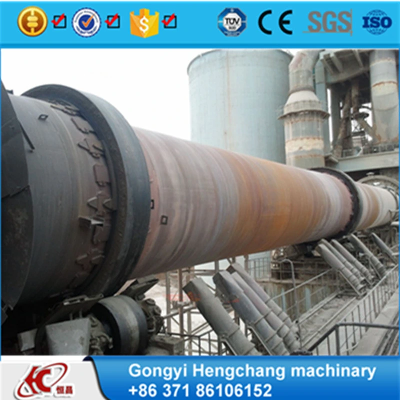Introduction of rotary kilnRotary calcining kiln types:Rotary
calcining kiln belongs to building material equipment, which can be
divided into cement kiln, metallurgy chemical kiln and lime kiln
according to different materials.Rotary calcining kiln
application:Rotary calcining kiln is used for making of cement
clinker and there are dry and wet methods to make cement.
Metallurgy chemical kiln is used in metallurgy industry and
ironworks for lean iron ore, chromium ore and ferronickel ore
calcimine. Rotary kiln is used for calcimine of high aluminum
vandal ochre in refractory material industry; For calcimine of
calotte and aluminum hydroxide in aluminum manufacturer; For
claiming of chrome sand ore and chrome powder ore in chemical
plant.The kiln is a cylindrical vessel, inclined slightly to the
horizontal, which is rotated slowly about its axis. The material to
be processed is fed into the upper end of the cylinder. As the kiln
rotates, material gradually moves down towards the lower end, and
may undergo a certain amount of stirring and mixing. Hot gases pass
along the kiln, sometimes in the same direction as the process
material (co-current), but usually in the opposite direction
(counter-current). The hot gases may be generated in an external
furnace, or may be generated by a flame inside the kiln. Such a
flame is projected from a burner-pipe (or "firing pipe") which acts
like a large bunsen burner. The fuel for this may be gas, oil or
pulverized coalWorking principle of rotary kilnThe wet
materials are conveyed to the hopper through the belt conveyor or
bucket elevator, and then enter into the feed end through the
hopper charger and the feeding pipe in sequence. The inclination of
the feeding pipe must be greater than the natural inclination of
materials in order to make the materials flow into the dryer
smoothly. The dryer cylinder with slight inclination with the
horizontal line. The materials enter from the higher end, and the
heat carrier enters from the lower ender; the two contact each
other from opposite directions, but there are also circumstances
that the heat carrier flows into the dryer body together with the
material.Technical parameters of rotary
kilnSpecifications(m)The size of the
kilnCapacity(t/h)Speed(r/min)Power (kw)Weight(t)Diameter (m)Length
(m)Gradient (%)φ 1.4× 331.43330.9-1.30.39-3.9618.547.5φ 1.6×
361.63641.2-1.90.26-2.632252φ 1.8× 451.84541.9-2.40.16-1.623078.2φ
1.9× 391.93941.65-30.29-2.933077.59φ 2.0×
4024032.5-40.23-2.2637119.1φ 2.2×
452.2453.53.4-5.40.21-2.4445128.3φ 2.5×
402.5403.59.0-10.50.44-2.4455149.61φ 2.5×
502.55036.25-7.40.62-1.8655187.37φ 2.5×
542.5543.56.9-8.50.48-1.4555196.29φ 2.7×
422.7423.510.0-11.00.10-1.5255198.5φ 2.8×
442.8443.512.5-13.50.437-2.1855201.58φ 3.0×
453453.512.8-14.50.5-2.4775210.94φ 3.0×
483483.525.6-29.30.6-3.48100237φ 3.0× 603603.512.3-14.10.3-2100310φ
3.2× 503.250440.5-420.6-3125278Detailed Photos /* March
10, 2023 17:59:20 */!function(){function s(e,r){var
a,o={};try{e&&e.split(",").forEach(function(e,t){e&&(a=e.match(/(.*?):(.*)$/))&&1
Related products about Supply Production Line Kaolin Magnesite Calcination Rotary Kiln
-
 Waste Tyre Plastic Recycling Machinery Machine Tire Crusher Production Line Rubber Crumb Grinding Machine Equipment Tire Shredder
Waste Tyre Plastic Recycling Machinery Machine Tire Crusher Production Line Rubber Crumb Grinding Machine Equipment Tire Shredder
-
 Stretch Plastic Blowing Pet Bottle Making Blow Molding Machine Bottles Stretch Automatic Pet Bottle Blowing Machine
Stretch Plastic Blowing Pet Bottle Making Blow Molding Machine Bottles Stretch Automatic Pet Bottle Blowing Machine
-
 Waste Plastic Pet Bottle, Water Bottle Flake, PP/HDPE/LDPE PE Film Jumbo Woven Bags Plastic Crusher Machine, Plastic Crushing Washing Recycling Machine
Waste Plastic Pet Bottle, Water Bottle Flake, PP/HDPE/LDPE PE Film Jumbo Woven Bags Plastic Crusher Machine, Plastic Crushing Washing Recycling Machine
-
 Type 2 Wall-Mounted Electric Car Charging Station 7kw /11 Kwelectric Vehicle Charging Station Home Wallbox AC EV Charger Single Phase or 3three Phase
Type 2 Wall-Mounted Electric Car Charging Station 7kw /11 Kwelectric Vehicle Charging Station Home Wallbox AC EV Charger Single Phase or 3three Phase
-
 G-View G12W Wholesale Auto Car LED Headlight Bulb High Power H13 H11 9005 H7 H4 Car LED Headlights LED Car Lights
G-View G12W Wholesale Auto Car LED Headlight Bulb High Power H13 H11 9005 H7 H4 Car LED Headlights LED Car Lights
-
 New Design Porcelain Round Plates Dinner Set for Wedding and Banquet
New Design Porcelain Round Plates Dinner Set for Wedding and Banquet
-
 China 2023 New Design Super Soft 100% Polyester Microfiber Knitted Oversized Decoration Hoodie Blanket
China 2023 New Design Super Soft 100% Polyester Microfiber Knitted Oversized Decoration Hoodie Blanket
-
 Handmade Art Creative Materials Thickened White Paper Cup DIY Disposable Handmade Colored Paper Cup
Handmade Art Creative Materials Thickened White Paper Cup DIY Disposable Handmade Colored Paper Cup



